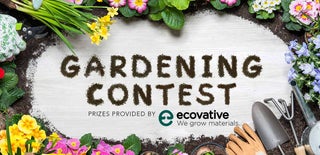Introduction: Sledge Straw Bale Plant Box
I had this broken sledge laying around in the garage and figured it would be a nice extra in my garden if I would make a plant box out of it. For a while, I wanted to have lavender in my garden, so after the plant box was finished I planted lavender. The result is a movable and nice looking plant box.
P.s. this is my first instructable, I hope you'll like it!
Step 1: Getting Materials and Tools
The list of materials and tools I used is the following:
Essentials:
- broken sledge (or use any object you'd like to build a plant box out of)
- straw bale
- fine chicken wire (5 mm x 5 mm will do)
- iron wire
- basic tools: pliers, hand saw, screw drivers (possibly), hammer (possibly)
- scissors/ hedge shears
Extra:
- bench grinder or file
- string
Step 2: Adjust the Sledge
In this step, a little creativity is needed. The chances are pretty small that you come across exactly the same sledge as I have right here, but basically what we need is a space to put the container in. I choose to get rit of the middle part of the seat of the sledge that resulted in a nice gap to put the container in.
Step 3: Make the Container
The container is made of pieces of fine chicken wire that are woven together by iron wire.
First, determine the right sizes. Take some extra chicken wire to make sure you have enough overlap. Mark the place where you want the corners of the container (this is the place where the bends will be made later). Once you have determined the right size for every piece, you can cut the chicken wire.
Second (optional), use a bench grinder or a file to clear the sharp edges. (These little nasty iron spikes can hurt you!)
The third step is to assemble the container. Using the pliers, you can pull the iron wire through the overlapped holes of 2 pieces of chicken wire. I skipped a few holes before putting the wire through the next hole again, since I found that it was quite stirdy this way.
You now have your chicken wire container!
Step 4: Making the Straw Fit Into the Container
Due to the way they pressed it, straw has a distinct texture. It's important that the wheat fibres are lying vertically. This way, it will be a lot easier to make a hole and put a plant in it. Growing plants on straw looks great, but a straw bale is not really easy to work with. It just totally desintegrates and since it's not solid, sawing is not particularly easy. However, with some effort you should be able to get the width and depth right. After that just put the straw into the container as far as possible. Now you can use a hand saw to adjust the height. It really helps to put a string or two around the outer part to keep them bound together.
Step 5: Planting Some Nice Lavender (or Another Plant of Your Choice)
The plant box is now finished, but probably some straw springs out and it just looks a bit messy. So, using hedge shears or scissors, cut away everything that's needed to get rid of to make it look nicer.
Now, a hole has to be made to put the plant in. Make it quite big! The plant needs nutrients from the soil, so make sure that it has enough. FIll the hole with soil and of course don't forget to put the plant in.
Step 6: Aftermath
After 4 weeks, the lavender is having a good time and so am I! It was my first project on straw gardening, but I'm really convinced that it could work out well for a lot of people. When I did some research on the internet, I found that not every plant will grow on straw. It was hard to find anything about lavender on straw, so I just considered this project as a little experiment. It seems to work pretty well though.
In short I want to point out the a few benefits of straw bale gardening.
Pros of straw bale gardening:
- You can do it anywhere. Since the straw bale can be conceived as a micro climate, it won't matter if you put them on contaminated grounds, a rooftop or on a field of grass. With suitable plants, it will grow no matter what.
- The straw will turn into compost, so no need to add extra nutrients.
- It's cheap. A straw bale will cost you a few bucks or euro's in my case.
Cons:
- You can't grow everything on straw bales.
As I said, this is my first straw bale project, so the pros and cons above are pulled from the internet. If you wanna know more about hay bale gardening, this is a good website to start with https://strawbalegardens.com

Participated in the
Before and After Contest 2017

Participated in the
Gardening Contest 2017













